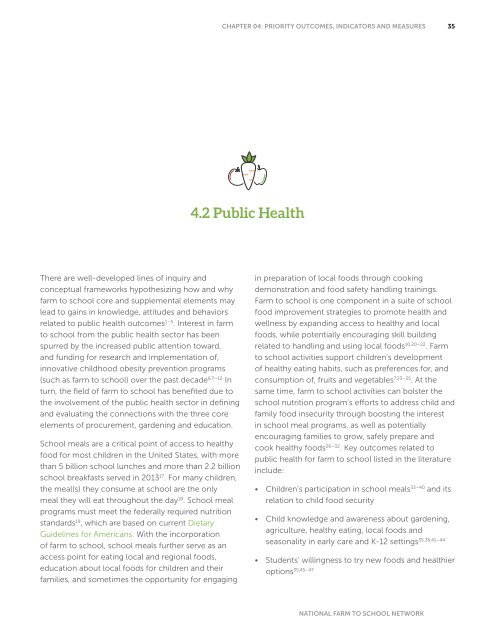Framework-08-25-14_web
Framework-08-25-14_web
Framework-08-25-14_web
You also want an ePaper? Increase the reach of your titles
YUMPU automatically turns print PDFs into web optimized ePapers that Google loves.
CHAPTER 04: PRIORITY OUTCOMES, INDICATORS AND MEASURES354.2 Public HealthThere are well-developed lines of inquiry andconceptual frameworks hypothesizing how and whyfarm to school core and supplemental elements maylead to gains in knowledge, attitudes and behaviorsrelated to public health outcomes 1–5 . Interest in farmto school from the public health sector has beenspurred by the increased public attention toward,and funding for research and implementation of,innovative childhood obesity prevention programs(such as farm to school) over the past decade 6,7–12. Inturn, the field of farm to school has benefited due tothe involvement of the public health sector in definingand evaluating the connections with the three coreelements of procurement, gardening and education.School meals are a critical point of access to healthyfood for most children in the United States, with morethan 5 billion school lunches and more than 2.2 billionschool breakfasts served in 2013 17 . For many children,the meal(s) they consume at school are the onlymeal they will eat throughout the day 18 . School mealprograms must meet the federally required nutritionstandards 19 , which are based on current DietaryGuidelines for Americans. With the incorporationof farm to school, school meals further serve as anaccess point for eating local and regional foods,education about local foods for children and theirfamilies, and sometimes the opportunity for engagingin preparation of local foods through cookingdemonstration and food safety handling trainings.Farm to school is one component in a suite of schoolfood improvement strategies to promote health andwellness by expanding access to healthy and localfoods, while potentially encouraging skill buildingrelated to handling and using local foods 10,20–22 . Farmto school activities support children’s developmentof healthy eating habits, such as preferences for, andconsumption of, fruits and vegetables 7,23–<strong>25</strong> . At thesame time, farm to school activities can bolster theschool nutrition program’s efforts to address child andfamily food insecurity through boosting the interestin school meal programs, as well as potentiallyencouraging families to grow, safely prepare andcook healthy foods 26–32 . Key outcomes related topublic health for farm to school listed in the literatureinclude:• Children’s participation in school meals 33–40 and itsrelation to child food security• Child knowledge and awareness about gardening,agriculture, healthy eating, local foods andseasonality in early care and K-12 settings 35,36,41–44• Students’ willingness to try new foods and healthieroptions 35,45–47NATIONAL FARM TO SCHOOL NETWORK


